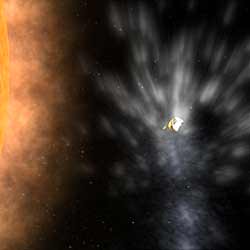
Artist illustration of a comet breaking up as it passes by the Sun. Image credit: NASA. Click to enlarge.
The Solar and Heliospheric Observatory (SOHO) spacecraft is expected to discover its 1,000TH comet this summer. The SOHO spacecraft is a joint effort between NASA and the European Space Agency. It has accounted for approximately one-half of all comet discoveries with computed orbits in the history of astronomy.
“Before SOHO was launched, 16 sungrazing comets had been discovered by space observatories. Based on that experience, who could have predicted that SOHO would discover more than sixty times that number, and in only nine years? This is truly a remarkable achievement!” said Dr. Chris St. Cyr, Senior Project Scientist for NASA’s Living With a Star program at NASA Goddard Space Flight Center in Greenbelt, Md.
Comets are chunks of ice and dust that zoom around the solar system in elongated orbits. This “dirty snowball” is the nucleus of the comet. Comet nuclei are thought to be cosmic leftovers, condensed remains of the gas and dust cloud that formed the solar system.
As a comet gets close to the Sun, solar heat liberates gas and dust from the nucleus, forming the coma, which is an extensive, bright cloud around the nucleus, and one or more tails. A comet’s dust tail can become millions of miles (kilometers) long as sunlight pushes the dust particles away from the Sun. Comets also have a tail of electrically charged particles (ions) that is usually fainter and is pushed away from the Sun by the solar wind, a thin stream of electrified gas that blows constantly from the Sun.
About 85 percent of the SOHO comets discovered so far belong to the Kreutz group of “sungrazing” comets, so named because their orbits take them very close to the Sun. The Kreutz sungrazers come within 500,000 miles (800,000 km) of the Sun’s visible surface. (Mercury, the planet closest to the Sun, is about 36 million miles (57.6 million km) from the solar surface.) SOHO has also been used to discover three other well-populated comet groups: the Meyer (at least 55 members), Marsden (at least 21 members), and Kracht (24 members) groups. These comet groups are named after the astronomers who suggested that the comets are related because they have similar orbits.
Because comets in a group have similar orbits, they are believed to be fragments from a larger comet that broke apart. Sungrazing comets can break up as they approach the Sun due to the Sun’s gravity and heat. It is likely that small fragments continue to break off all around their orbits, because SOHO observes a stream with tiny Kreutz members reaching the Sun almost every day, and bits as small as these would have simply vaporized if this had happened near the Sun. Most of these comet fragments are not visible from Earth because their small size makes them extremely faint. A typical comet nucleus is as big as a mountain, while most of the SOHO comets are only as big as a large room or small house.
However, since the Kreutz group is so numerous, the parent comet that shattered to create Kreutz comets is estimated to have been truly immense, about 60 miles (100 km) across. The great comets of 1843 and 1882, with long tails that were spectacular to the naked eye were large Kreutz members, as was comet Ikeya-Seki in 1965. The 1882 and 1965 comets almost certainly broke off from each other the previous time they were near the Sun, when the combined comet was likely seen as the comet of 1106.
Many SOHO comet discoveries have been by amateurs using SOHO images on the internet. SOHO comet hunters come from all over the world; the United States, United Kingdom, China, Japan, Taiwan, Russia, Ukraine, France, Germany, and Lithuania are among the many countries whose citizens have used SOHO to chase comets.
Almost all SOHO’s comets are discovered using images from its Large Angle and Spectrometric Coronagraph (LASCO) instrument. LASCO is used to observe the faint, multimillion-degree outer atmosphere of the Sun, called the corona. A disk in the instrument is used to make an artificial eclipse, blocking direct light from the Sun so the much fainter corona can be seen. Sungrazing comets are discovered when they enter LASCO’s field of view as they pass close by the Sun. “Building coronagraphs like LASCO is still more art than science, because the light we are trying to detect is very faint,” said Dr. Joe Gurman, U.S. Project Scientist for SOHO at NASA Goddard. “Any imperfections in the optics or dust in the instrument will scatter the light, making the images too noisy to be useful. Discovering almost 1,000 comets since SOHO’s launch on December 2, 1995 is a testament to the skill of the LASCO team.”
SOHO successfully completed its primary mission in April 1998, and it has enough fuel to remain on station and keep hunting comets for decades, assuming the LASCO instrument continues to function. Additionally, NASA’s twin Solar Terrestrial Relations Observatory (STEREO) spacecraft, scheduled for launch in February 2006, each have two instruments that could be used to discover comets: a coronagraph like LASCO and a heliospheric imager.
Original Source: NASA News Release
